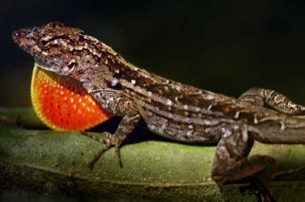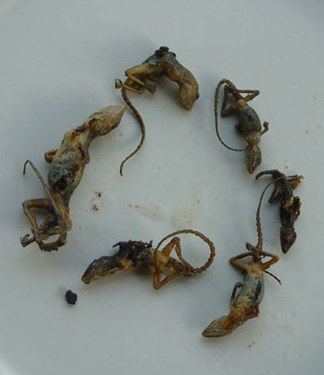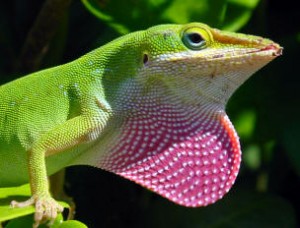
“Did you clean them” I asked a friend who might want to remain anonymous.
“No” he said.
“You cooked them whole?”
“Yes.”
“You ate them head, tail and all?” I asked.
“Yeph.”
“What did they taste like?”
“Bacon.”
Wow, I thought. That might be the to solution to the Cuban anole invasion: Eat them.

Deep Fried Brown Anoles
The Cuban Anole or Brown Anole, came to the United States via Key West around 1900. Now they are all over the place, in some locales up to 2,000 per acre. They are little bullies driving out the native Green Anole. To add to the confusion the Green Anole prefers to be green but can turn brown on occasion whereas the Cuban/Brown Anole is always brown, never green. The Cubans (Anolis sagrei) are slightly more dragonesque in appearance. Mature males usually sport a crest-like ridge running down the back whereas the natives greenies are slim and fine bone especially in the head. Further, the Brown Anole can voluntarily drop off its tail as a defense mechanism. It will partially grow back.
While the Brown Anole is crowding out the Green Anole some think the Green Anole is responding to the pressure by moving higher up in plants and trees leaving the Brown Anole to inhabit lower plant areas and the ground. Green Anoles like foliage where as the Brown likes to run along the ground.
Most of us have seen the Cuban Anole strutting his stuff, doing pushup and waving his throat dewlap, a bright pink to orange fold of skin. It’s to tell other fellows to stay away, this rake handle is my territory. And, if a lizard lass is looking for a mate he is saying, “I’m king on rake mountain.”
Actually lizards are the intellectuals of the reptile world, and anoles have different things to say. Their push ups and dewlap waves are not random. Among their messages are: Three head bobs, two dewlap waves, head up, then a series of small bobs. Another is one large bob, done slowly, a pause, two dewlap waves, then raise the head and do a series of small head bobs. Anole Morse Code. We may not know what it means, but they seem to understand quite well, and have for about 100 million years.
Anoles usually eat insects, and only live insects. The insect has to move for the anole to be interested in it… kind of like a dog chasing a car… Their native diet consists mainly of small arthropods, annelids, and mollusks. Cannibalistic, they are also short lived, 18 months on average, 36 occasionally. They are sexually active their second year. If you see a male displaying he will probably be dead that following winter season. Usually a male will keep two lady lizards happy and each will lay one or two egg a week, alternating ovaries.
Anoles can grow to eight inches though five is about as big as they get locally (one advantage of occasional frost perhaps.) They are found in warm areas of North America up to about the latitude of central Georgia, Central America, South America, and in Hawaii. Whether they are in Taiwan and Guam is a bit of a debate. Usual weight is six to eight grams (males) or four to an ounce. Females half that. They do not make good pets and when capturing them they will bite but they can only hang on and it does not hurt. In fact, kids in Florida often catch them and let them latch onto their earlobes and wear them as living earrings. However, as all reptiles can carry salmonella, wash your hands and ear lobs after handling. Clearly they are not to be eaten raw.
You can capture them by hand (particularly after dark) or take them from your cat. As for cooking, you can freeze them first or drop them in hot oil, and or both. Add a little pepper and bon appetit.


